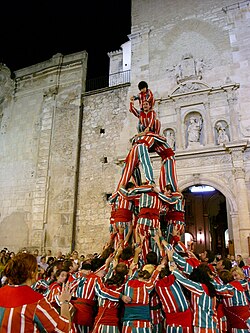Muixeranga
Both traditions share the same origin, the "Moixiganga", (a series of dances of human towers) once found throughout the Iberian Peninsula.
The feast day of Our Lady of Health, patroness of Algemesi is September 8, and commemorates the legendary discovery in 1247 of a statue depicting the Madonna and Child.
In the early 18th Century the dances belonged to different guilds; for example, the “Muixeranga” was the domain of construction workers, the “Carxofa” of the weavers, and so on.
UNESCO has recognized the ritual, festive and community participation dimension of the Valencian celebration Our Lady of Health as part of the "intangible heritage of humanity".
At the centre, visitors can learn about the history, the ritual acts, the dances, the music and the costumes of the celebration, as well as enjoying many stories from the event.
However, the first concrete date comes from the town account book in the year 1733, when the dulzaina players employed in the festival were given an annual stipend.
A group including writer Martí Domínguez i Barberà, Mayor Manuel Rico, Vicent Raga, festival organiser in the Capella neighbourhood, and Father Vicent Castell Maiques, with the support of the students’ association Associació d'Antics Alumnes dels Maristes, were responsible for re-launching it under the guidance of Tomàs Pla.
[2] Eloi Miralles, a member of the Colla de Castellers de Vilafranca del Penedès, arranged for the muixeranguers to visit the Penedès capital and on August 31, 1978, the Muixeranga rose up in Villafranca's main square, banishing forever that lack of visibility which might have proved fatal.
The procession, which begins with the mysteries and martyrdoms, (short theatrical pieces, performed by groups of children), has a scrupulous order with the towers of the Muixeranga second, followed by the Bastonets, the Carxofa, the Arquets, the Pastoretes, Bolero or llauradores, and the city band.
Starting from the Basilica of St. James, the traditional dances of Algemesí and the image of the patron pass back through the old city, repeating the original itinerary of 1724.
The Muixerangas, a set of tableaux composed of human towers and representative figures, has several stages, and opens with all muixerangueros dancing in two rows with candles burning.
The dance is accompanied by the music of tabalet (a drum) and dolçaina (valencian shawm), with a very old characteristic tune, of unknown author.








